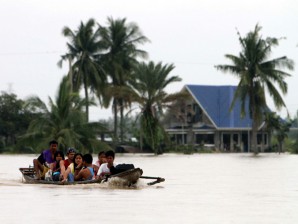Worst over in Bulacan: Floodwaters receding

A boat is the only means of transportation in Gugo, Calumpit in Bulacan after the village was submerged in water due to the rains spawned by Typhoons “Pedring” and “Quiel”. LYN RILLON/INQUIRER
The worst of the flooding in Bulacan province appears to be over with waters slowly receding days after back-to-back typhoons hit Luzon last week.
The subsiding water allowed relief workers to deliver food, medicine and dry clothes to families who had waited out the floods on their roofs and upper floors of their homes.
“We have no food to eat, and no clean drinking water,” construction worker Orly Nabong said as he joined hundreds of victims lining up for relief goods on higher ground in Calumpit, one of the worst-hit towns.
“The water is slowly going down so we think we can wait it out, but we need supplies,” he said.
Nabong, 52, said adult members of his extended family remained on the second floor of their home, including his siblings, although the children had already been taken to an evacuation center.
Calumpit is part of Bulacan, a flat farming region that was particularly hard hit by the heavy rains of Typhoons “Quiel” and “Pedring.”
Quiel pummeled Luzon on Saturday, hitting many of the same areas that Pedring slammed five days earlier.
58 killed
Fifty-eight people have so far died in the two storms, and 28 remain missing, according to the civil defense office.
Another 360,000 people are either in evacuation centers or stranded in the flooded areas and in need of relief, the office said.
Officials said Pedring and Quiel were among the most powerful typhoons this year.
At the height of Pedring’s fury last week, authorities released water from dams which had reached critical levels, adding to the flooding.
Threat had passed
The government had warned on Sunday that rains from Quiel could stream down from mountain ranges north of the flood zones and lead to higher levels of water. By Monday morning, however, the threat had passed.
“The amount of rainfall from Quiel wasn’t enough to cause more flooding, although some areas will likely remain under water for several days,” said Benito Ramos, the national civil defense chief.
Some towns have endured flooding nearly two stories deep over the past week, although authorities said the water on Monday was about chest high.
Makeshift command post
In Calumpit, residents waded through waist-deep flooding to reach the makeshift command post where food was distributed in sacks and a water filtration system was set up.
“We need clean drinking water and perhaps purification tablets,” said Cloie Cruz, 26, who left her parents and three siblings at dawn to fetch supplies.
Rescuers were also finally able to reach areas previously cut off by raging currents, allowing them to bring medicine or to ferry those needing medical attention to evacuation centers or clinics.
San Roque Dam
In Pangasinan province, operators of the San Roque Dam continued releasing water through two spillway gates, at a height of a meter each, to bring down the reservoir level to 280 meters above sea level (masl).
At 4 p.m. on Monday, the water level at the San Roque Dam was 285.17 masl.
“The [water] release will be maintained… due to the potential threat of Typhoon ‘Ramon’ and [for the dam] not to add to the inflow of water from Tarlac [that is] affecting the downstream areas,” Tommy Valdez, vice president for corporate social responsibility of San Roque Power Corp., said in a text message.
In Isabela province, the Magat Dam continued releasing water on Monday as the reservoir’s level reached 192.98 masl, just .02 masl to its critical level.
Saturnino Tenedor, dam instrumentation section chief, said the facility had been releasing an average of 1,286 cubic meters per second (cms) while at least 1,126 cms were flowing into the reservoir.
Residents of 100 low-lying villages in the province have been asked to be on alert as water released by the dam may submerge their communities.
“We have to be always ready. We have yet to get a full sleep since Pedring and Quiel pummeled us,” said Delfin Bulan, 64, a resident of Bunnay village in Angadanan town.
At least four bridges remained impassable due to floods and swollen rivers in the province. These are the Alicaocao, Cabagan-Santo Tomas, Santa Maria-Cabagan and Pigalo bridges. Reports from AFP and Inquirer Northern Luzon














